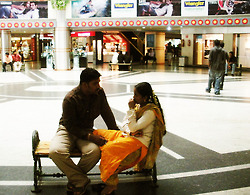
It was high monsoon season. Rain-dodging families, teenagers and the elderly were in search of a retreat: a place to gather, stroll and dig into their lunch tiffins away from the oppressive heat and humidity. As India’s leading builder of enclosed shopping malls, Mumbai granted refuge to its citizens in the form of air-conditioned glass and steel retail oases. Plagued by high vacancy and low purchasing rates, Mumbai’s new breed of shopping malls had become a neighborhood stomping ground for a city with a serious dearth of open public space and a mean appetite for public spectacle.
In 2008, I spent eight weeks in Mumbai, Bangalore and Pune visiting over 20 newly built shopping malls. Beyond witnessing global brands competing to cozy up to the emerging middle class and developers enacting neoliberal hallucinations to become Shanghai, I was interested in seeing how people used malls for everyday purposes other than shopping. Particularly in Mumbai, a city of 18 million residents with less than one square meter per person of open public space, were shopping malls a remedy for overcrowding? Were the malls becoming a second “nature,” an indoor city of clean air, benches and space to stroll?
In this photo essay of shopping malls – between 90,000 to 1.2 million square feet in size and one to eight years in age – I try to capture moments of non-consumption, in which people are appropriating the resources of retail to enhance their quality of life and have a little fun. I noticed how culture was constantly winning over consumption. Despite aggressive visual branding and explicit inducements to pursue shopping fantasies, reality ruled the mall. People were using malls to go for walks, meet up with lovers, or shrug off their slippers and settle in for a nap. In addition to reclining on the benches and ledges of mall entrances and atria, friends catching up or checking their phones would occupy the displays of living rooms and televisions. Rather than remain vigilant of shoplifters, security guards were poised at the bottom and top of escalators: ushering up and off giddy grown-ups venturing on their first rides on mechanical stairs. And to affordably enjoy the ambiance of the food court, large families or groups of friends would purchase a single soda or piece of pizza to earn them the right to a table, and then fill the rest of the meal with food from their own set of tiffins.
Overall, the building’s amenities were themselves the objects of entertainment and exploration. Indian consumers were happy to dip their toes in the waters of Western retail, testing the temperature of what new shopping environments had to offer, without committing to major purchases. In his analysis of the boom in shopping mall construction, Raju Bist confirms that the majority of mall goers are spectators not shoppers: ‘Some of the visitors are serious shoppers, attracted by the convenience of buying a wide variety of goods under one roof at economical prices. But most are partaking of new experiences – gawking at luxury goods, cooling off in air-conditioned comfort and enjoying an ambiance seen only in Hollywood movies up until now’ (2004). Some shopping malls counteracted this practice by instating strict admittance policies, granting entrance only to shoppers who could show a credit card or a mobile phone to security as a way of proving their status as potential consumers. Although these polices were scraped after customer complaints, there remains a tension between mall owners eager to turn a profit and a public more interested in riding the escalators. If Indian consumers are willing to spend time, but not money at shopping malls, can there be a balance struck between public space and private gains? And if not, and malls continue to provide the public with vital open, recreational space they crave, could the city step in to subsidize overhead costs? Perhaps a private-public partnership is what’s in store next monsoon season.
See more photos from shopping malls in Bangalore and Mumbai here.
Sources:
Bist R. (2004). ‘The great Indian mall boom,’ Asia Times.
Thirani N. (2012). ‘India’s Real Estate Developers Predict New Construction Boom,’ The New York Times, December 11.

